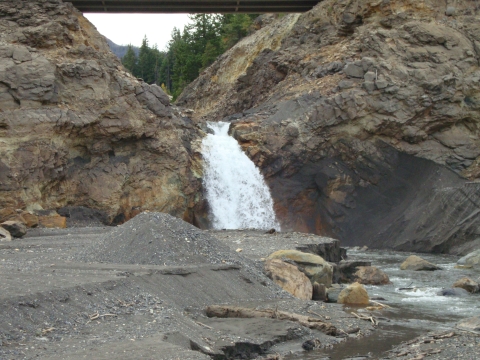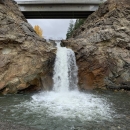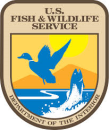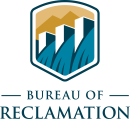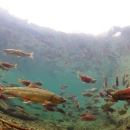States
WashingtonThis project will place the South Fork Tieton River back into its original channel and eliminate a fish passage fish passage
Fish passage is the ability of fish or other aquatic species to move freely throughout their life to find food, reproduce, and complete their natural migration cycles. Millions of barriers to fish passage across the country are fragmenting habitat and leading to species declines. The U.S. Fish and Wildlife Service's National Fish Passage Program is working to reconnect watersheds to benefit both wildlife and people.
Learn more about fish passage barrier that forms in September as Rimrock Reservoir is drawn down. Under current operations, the barrier is a hazard to out-migrating post-spawn bull trout and blocks spawning access for kokanee salmon. The improved fish passage will allow more flexibility in management of the Yakima Basin Project as a whole and could move the Tieton River below Tieton Dam to a more natural flow regime. This would benefit Middle Columbia River steelhead that spawn below the dam and facilitate out-migration of juvenile Chinook, sockeye, and Middle-Columbia River steelhead in the lower Yakima River in the spring. The improvements will reduce post spawn mortality of bull trout and increase the overall productivity of Rimrock by allowing spawning migration of kokanee, which are currently totally blocked from migration into South Fork Tieton River.
The original National Forest Road 1200 was constructed around 1931 in association with the construction of Tieton Dam, which was completed in 1936. The road was part of the State Highway system until 1951, when State Route 12 on the north side of the reservoir was constructed. There were a series of agreements between Yakima County and the Forest Service for maintenance of the road, beginning in 1966. By 1985, the wooden log trestle bridge crossing the Southfork Tieton was failing; the county and U.S. Forest Service entered into an agreement to replace the bridge.
Southfork Tieton’s natural alignment at the crossing was between a spur of weak volcanic rock on the west bank, and a slow moving glacial-clay landslide on the east bank. In order to avoid construction on the east bank in the landslide, a river channel was cut through the volcanic rock spur, and the bridge erected over that cut. The natural channel was then filled and the road realigned. Unfortunately, immediately downstream of the bridge, the rock spur was vertical, creating a 40-foot waterfall when the reservoir is drawn down. Under current operations, the waterfall creates a fish blockage from September thru April.
The Southfork Tieton supports the largest bull trout population in the Yakima Basin. Through an agreement between the Service and Bureau of Reclamation, Rimrock Reservoir is held high until August 10 each year to provide adequate upstream passage for spawning bull trout. As the reservoir is drawn down the falls become a passage barrier for kokanee, a prey source for bull trout. Yakama Nation has proposed the introduction of sockeye to Rimrock Reservoir after fish passage has been constructed at Tieton Dam (currently in development). Eliminating this fish passage barrier would provide access to high-quality spawning habitat for introduced sockeye.
Quick Facts:
| Project Status | In Development |
| Location | WA, Yakima |
| NFPP Project Funding | $400,000 |
| Restoration Techniques | Fishway |
| Accomplishments | 12.25 Stream Miles Reopened |
| Project Partner Lead | Yakima County |
| Primary Species Benefited | Bull Trout |
The National Fish Passage Program combines technical expertise with a track record of success.
Implemented primarily through the Service's Fish and Wildlife Conservation Offices, the National Fish Passage Program provides financial and technical assistance to partners across the country. Since 1999, the program has worked with over 2,000 local communities, Tribes, and private landowners to remove or bypass over 3,400 barriers to fish passage and reopen access to over 61,000 miles of upstream habitat for fish and other animals. Staff have expertise in fish migration and biology as well as financial, engineering, and planning assistance to communities, Tribes, and landowners to help them remove barriers and restore rivers for the benefit both fish and people.
Fish passage project proposals can be initiated by any individual, organization, government, or agency. However, proposals must be submitted and completed in cooperation with a Fish and Wildlife Conservation Office. (Please note that fish passage projects being used for federal or state compensatory mitigation or required by existing federal or state regulatory programs are not eligible for funding through the National Fish Passage Program.)
CONTACT A FISH PASSAGE COORDINATOR IN YOUR AREA TO GET STARTED.

